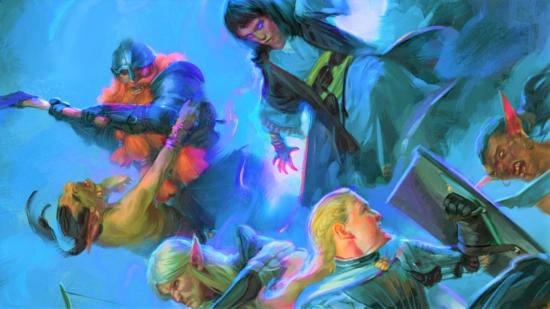Everyone thinks they know how the DnD Invisibility 5e spell works. ‘Wave your hands, chant some words, and your target is basically gone, right?’ thinks the Wizard. ‘I’ve become a stealth master’, the Barbarian whispers as their visage fades to nothing. ‘Nothing can stop me now’, hums the chaotic Bard who’s off to play some pranks. All of these characters – and their players – may sadly have the wrong end of the stick.
To fully grasp Invisibility 5e, you need to understand a lot of keywords from the Player’s Handbook. Heck, it’s not even clear which spells designed to counter Invisibility do what you need them to. It’s almost fitting how unclear a spell that turns people invisible in D&D can really be.
To provide some clarity, we’ve put together the DnD Invisibility 5e spell guide. Here you’ll find all the basic information you need to use the spell in-game, as well as a deep dive into the keywords and TTRPG tips you need to stop Perception-check-based arguments breaking out at your table.
All clear? Good.
Here’s everything you need to know about the DnD Invisibility 5e spell:
- Invisibility 5e features
- How to cast Invisibility 5e
- How Invisibility 5e works
- Who can cast Invisibility 5e
- Pros and cons of Invisibility 5e

Invisibility 5e features
| Level | Two |
| Casting time | One action |
| Duration | One hour (with concentration) |
| Range / Area | Touch |
| Attack / Save | None |
| School | Illusion |

How to cast Invisibility 5e
Firstly, Invisibility 5e requires concentration. This means you can’t cast another spell that requires concentration, die or fall unconscious, fail a Constitution saving throw when you take damage, or become distracted by your environment (as ruled by your DM).
The spell also requires verbal, somatic, and material components. This means, in addition to chanting and doing physical gestures, you’ll need an eyelash encased in gum arabic for the spell to work.
Swift spells: A guide to DnD haste 5e
Got everything you need? Now casting is simple. Touch your intended creature (this could be you, or someone else), and it’ll become invisible until the spell ends – or until the target attacks or casts a spell. Anything the target is wearing or carrying is also invisible as long as it’s on their person.
There’s a fun extra level to this spell for higher-level casters, too. If you cast Invisibility using a third-level or higher spell slot, you can target an additional creature for every additional spell slot level you use. This means casting Invisibility with a seventh-level spell slot will be enough to conceal a full party of five.

How Invisibility 5e works
Casting Invisibility 5e sounds simple, but we need to learn more about the invisible condition to really understand its effects. There are two key impacts of the invisible condition – let’s break each of them down.
Hold-some: A DnD Hold Person 5e spell guide
According to the Player’s Handbook, “an invisible creature is impossible to see without the aid of magic or a special sense”. “For the purpose of hiding, the creature is heavily obscured. The creature’s location can be detected by any noise it makes or tracks it leaves.”

The first sentence tells us that there are magical abilities (like the See Invisibility spell) and senses (like Truesight) that can bypass Invisibility. The part about hiding introduces us to another keyword we need to understand – “heavily obscured”.
The PHB defines a heavily obscured area as one that “blocks vision entirely”, and creatures in these areas are effectively blinded. “Blinded” is another condition in itself – it means the affected creature automatically fails ability checks that require sight, its attack rolls are disadvantaged, and attack rolls against it have advantage.
How about no: How to use DnD counterspell 5e
Conveniently, this adavantage/disadvantage section is the second key impact of the Invisibility spell. This tells us the Invisibility spell basically functions as a big cloak that obscures the target and blinds everyone else. Sight-based Perception checks are an automatic fail, but an Invisible creature still needs to roll to hide because the sounds they make aren’t obscured.
One important point to note is that spells like See Invisibility only negate the first bullet point in the spell’s list of effects. The caster can now see invisible people, but without a spell like Faerie Fire, everyone still suffers disadvantages against the Invisible creature in combat.

Who can cast Invisibility 5e
Invisibility 5e can be learned by Bards, Sorcerers, Warlocks, Wizards, and even Artificers. Because this can be a Wizard spell, classes that can learn Wizard spells through certain subclasses (looking at you, Arcane Trickster Rogue and Eldritch Knight Fighter) can take this spell, albeit at slightly later levels than the other classes listed here. Circle of the Land Druids will also be able to learn Invisibility.

Pros and cons of Invisibility 5e
The wording for Invisibility is still vague, which is a definite downside. The spell says anything you’re carrying also becomes invisible, for example. Many players would assume anything is implied to be an inanimate object, but what if a player suggests carrying a Halfling Paladin into battle? What then happens when the Halfling attacks – since the target of the spell hasn’t attacked, does everyone still technically remain invisible? Does the Halfling appear but its bearer remains hidden? Does that defeat the whole object of the spell?
Admittedly, a floating Halfling Paladin going to war sounds like a hilarious time to us. If you’ve got (or are) a DM who loves a ‘rule of fun’ rules fudge, then this wording won’t be as much of an issue – maybe you’ll even see it as something of a pro. But it’s definitely something to take with a pinch of salt if you’re playing a gritty survivalist campaign that’s doing things totally by the book.
By our standards, Invisibility is a pretty effective spell for its level. There’s no possibility of it failing or being resisted (seemingly even if you cast it on an unwilling target, as there’s not a saving throw in sight). You might not lose your invisibility when attacking if you’re affected by the fourth-level spell Greater Invisibility, and you might need material components to cast, but to be able to make multiple creatures invisible for way longer, we think you get more bang for your buck out of regular old Invisibility.
There are plenty of roleplaying options with Invisibility. The max duration means you could easily use this spell to stealth your way through a setting like Strahd’s castle – though the chance of being heard still keeps the tension high. Or, if you’re feeling chaotic, you can ramp up the gags with that floating Halfling escapade we pitched earlier.
Using invisibility in combat can also give your party a real boost if used at the right time (even if attacking with that advantage you have will end the spell). Be warned, though – simply turning Invisible in front of an enemy doesn’t stop their sword from finding you; you actually have to hide if you want to feel the full effects.
